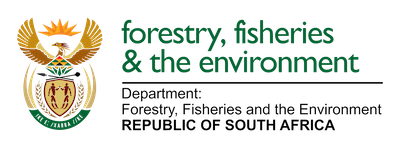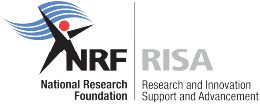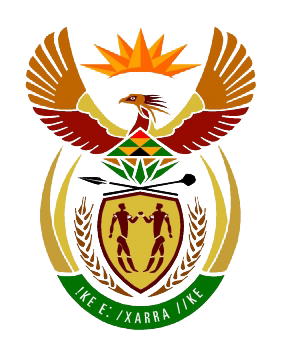
by Ria Olivier | May 7, 2024 | Announcement, Antarctica, Research, SANAP
 Announcing a 2nd Edition of the Special Issue focused on “Antarctic Remote Sensing Applications” that will be published in the journal Remote Sensing (IF: 5.000).
Announcing a 2nd Edition of the Special Issue focused on “Antarctic Remote Sensing Applications” that will be published in the journal Remote Sensing (IF: 5.000).
 The focus of this Special Issue will be on changes that have been and are undergoing in Antarctica mostly driven by climate change but as well by tectonics, volcanism, and erosion, that causes adaptation of Antarctic biota’s occupation and mobility, and of Human presence. Research papers focused on Antarctica that analyze data acquired by remotely operated sensors within the Remote Sensing scope are welcome to this special issue, in particular:
The focus of this Special Issue will be on changes that have been and are undergoing in Antarctica mostly driven by climate change but as well by tectonics, volcanism, and erosion, that causes adaptation of Antarctic biota’s occupation and mobility, and of Human presence. Research papers focused on Antarctica that analyze data acquired by remotely operated sensors within the Remote Sensing scope are welcome to this special issue, in particular:
- Antarctic climate change effect on ice sheet and permafrost state and evolution,
- Antarctic sea level rise and sea surface temperature anomalies,
- Antarctic landform formation by tectonics, volcanism, and erosion,
- Antarctic biota occupation and mobility,
- Antarctic past and recent human presence.
SPECIAL ISSUE Information
Researchers working on these topics express an interest in contributing to this Special Issue by sending a potential title, list of authors and abstract (of about 300 words) to gprates@ualg.pt and/or to submit your contributions.
The submission deadline will be 30th September 2024.
CONTACT:
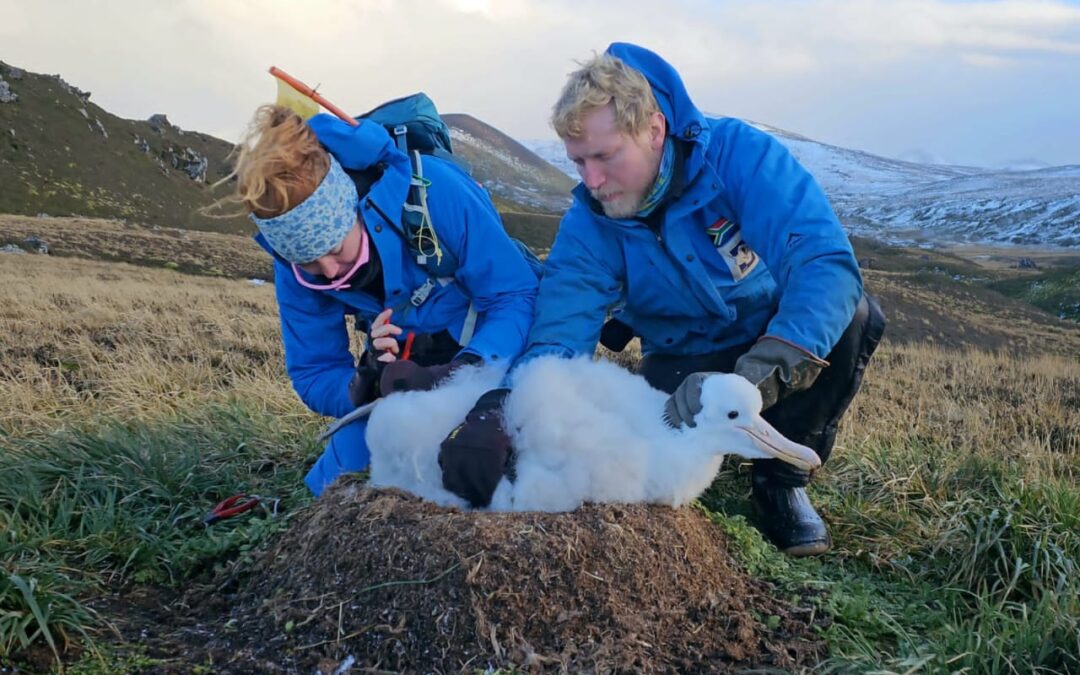
by Ria Olivier | Apr 29, 2024 | Marion Island, Research, Take-Over Operations, Uncategorised
Marion Island Take-Over 2024 Ornithology Projects: Avian scavengers as indicators of recovery of an island biota and the FitzPatrick long-term monitoring of Albatross and Giant Petrels.
The activities during the take-over 2024 will be divided into (1) completing the activities of the 2021/23 SANAP project on avian scavengers, and (2) ensuring the smooth passing of the FitzPatrick Institute seabird long-term monitoring on to the South African Polar Research Infrastructure (SAPRI).
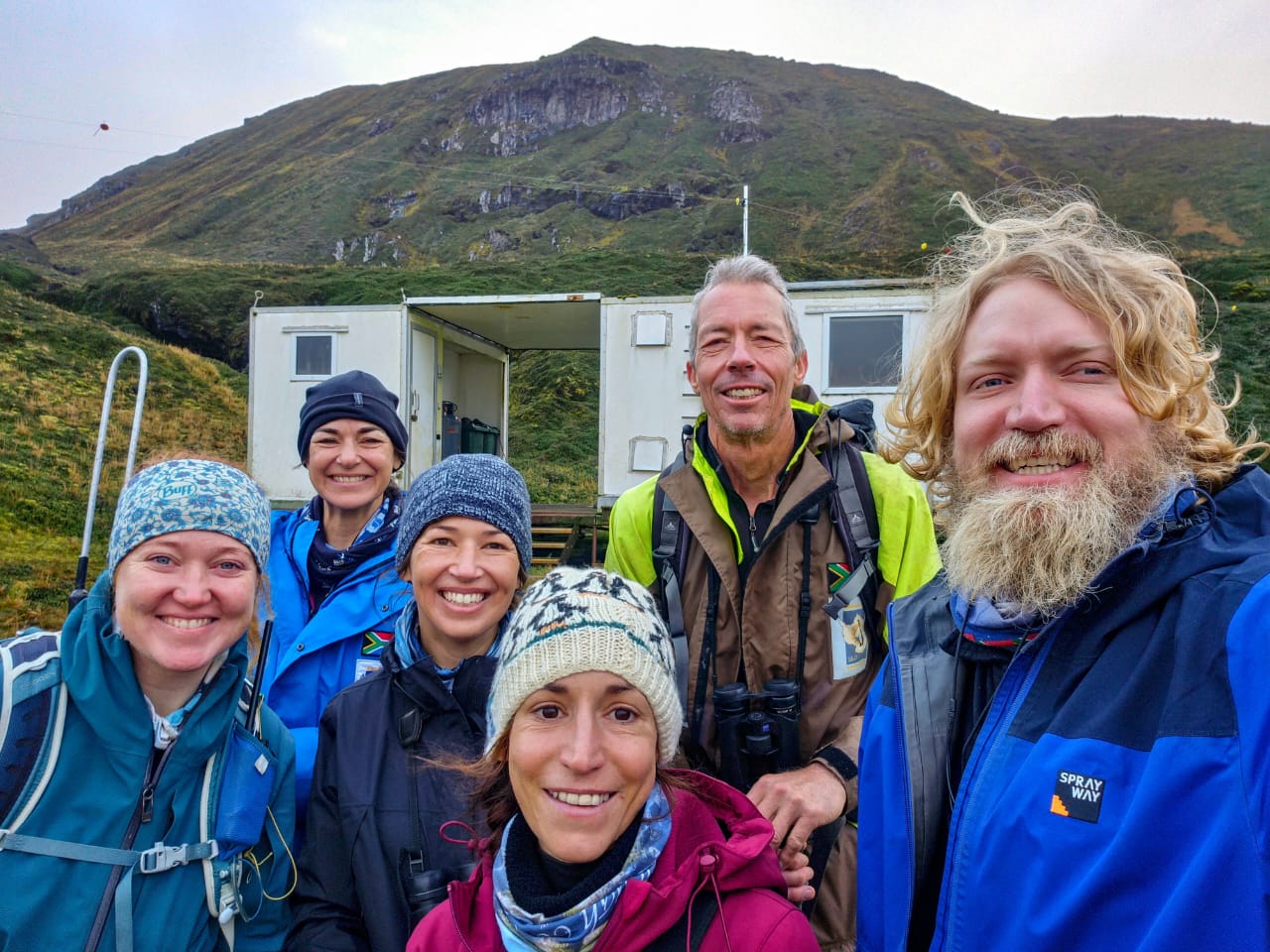 ABOVE: Michelle Jones (M80), Vanessa Steven (M81), Prof Susie Cunningham (UCT FitzPatrick PI), Rhiannon Gill (M81), Prof Peter Ryan (UCT FitzPatrick), Chris Jones (M80)
ABOVE: Michelle Jones (M80), Vanessa Steven (M81), Prof Susie Cunningham (UCT FitzPatrick PI), Rhiannon Gill (M81), Prof Peter Ryan (UCT FitzPatrick), Chris Jones (M80)
Avian scavengers as indicators of recovery of an island biota : Since 2021, our SANAP project focussed on the three poorly known avian scavengers: Brown Skua, Kelp Gull, Black-faced Sheathbill, as well as some of the skua’s prey, the burrowing seabird species. Our project filled identified scientific gaps that were crucial for best planning of the mouse eradication and development of appropriate mitigation measures, and established baselines for the scavenger guild and their prey base against which the impact of a successful mouse eradication can be measured in years to come. The takeover 2024 will see the closure of this project that we are aiming to restart at the time of the mouse eradication.
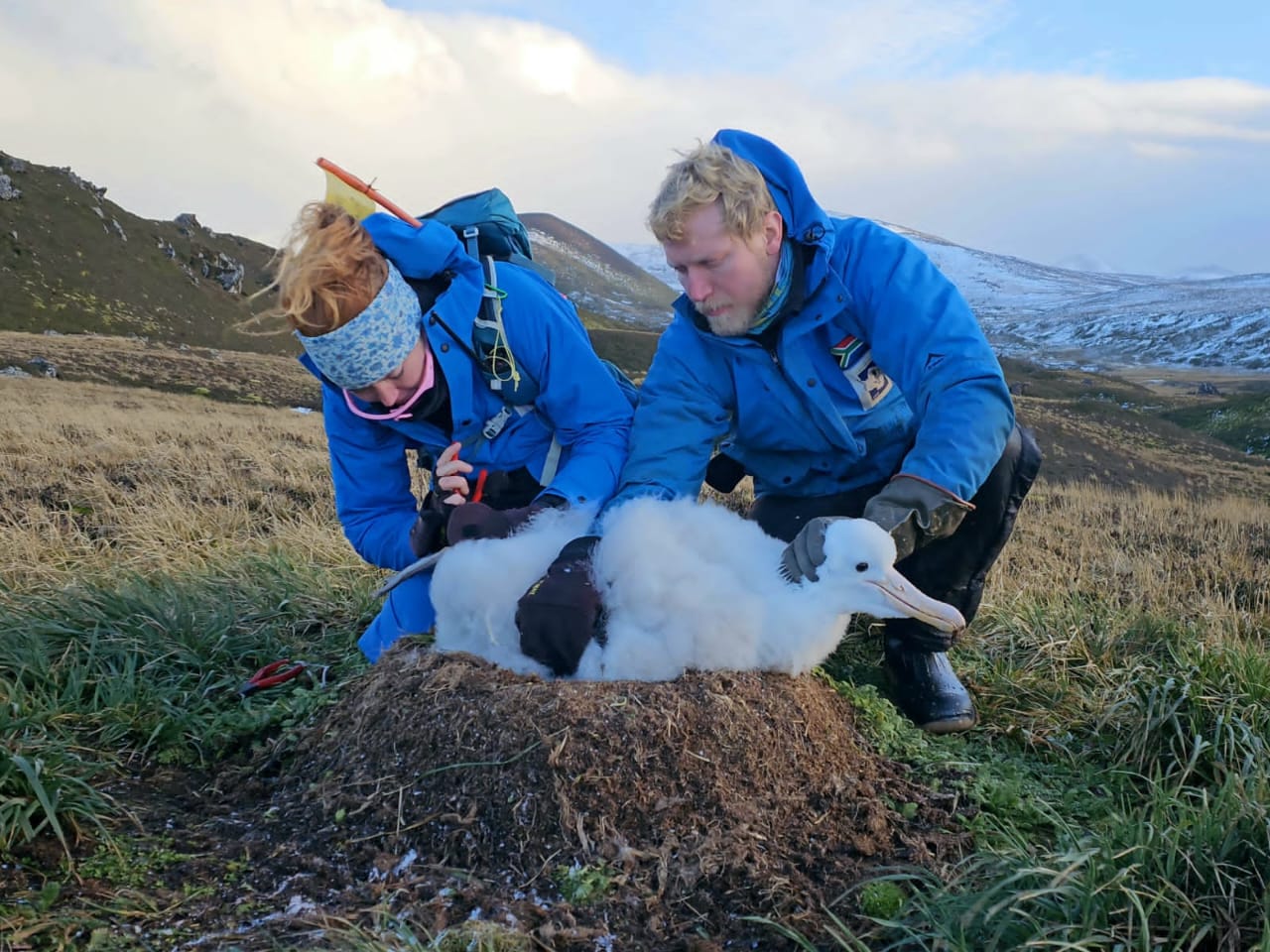
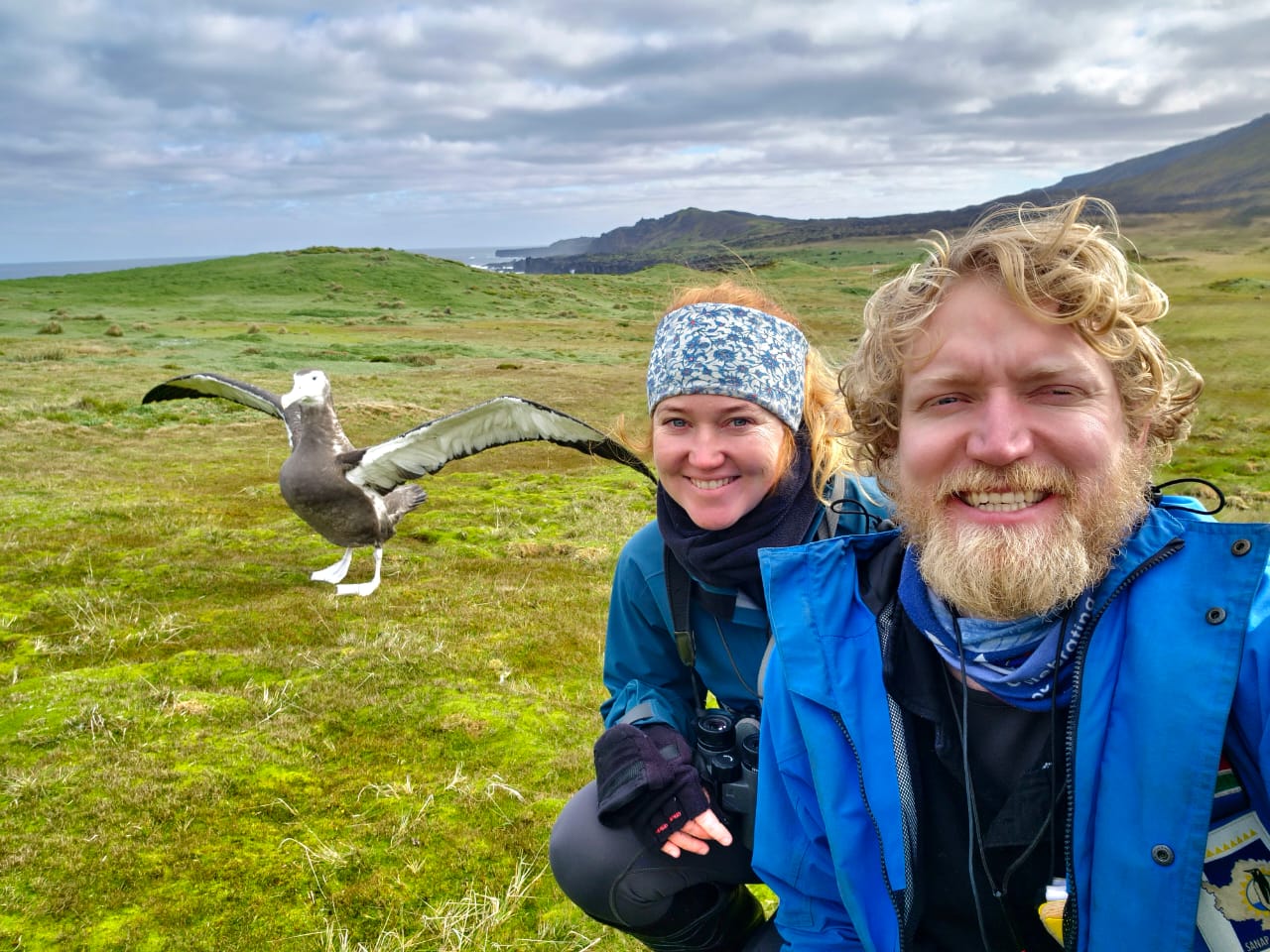 Above: Chris and Michelle Jones working with the Wandering Albatross during overwinter period
Above: Chris and Michelle Jones working with the Wandering Albatross during overwinter period
The FitzPatrick long-term monitoring of Albatross and Giant Petrels: The long-term demography monitoring of Wandering and Grey-headed Albatrosses and Northern Giant Petrels at Marion Island was started by the FitzPatrick Institute of African Ornithology (UCT) in the early 1980s. To ensure its continuity for years to come, it will become SAPRI’s responsibility from April/May 2024. In the forthcoming takeover, all information regarding the monitoring will be passed on to SAPRI to ensure the continuity in the data collected. Further, the annual whole island count of Grey-headed Albatross fledglings will be conducted and Wandering Albatrosses will be carefully checked to detect any potential mouse injuries that were first detected in breeding adults in April 2023.
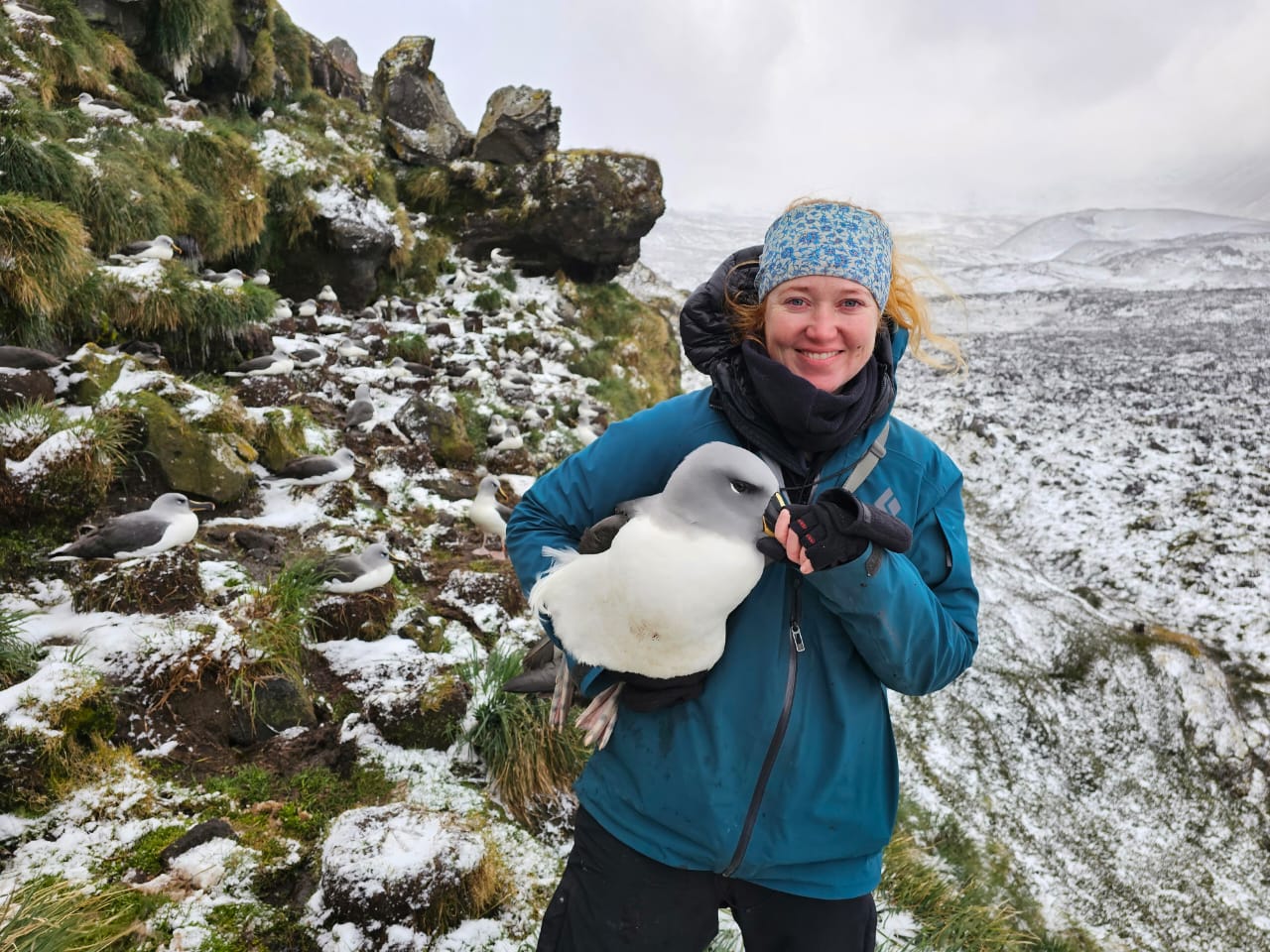
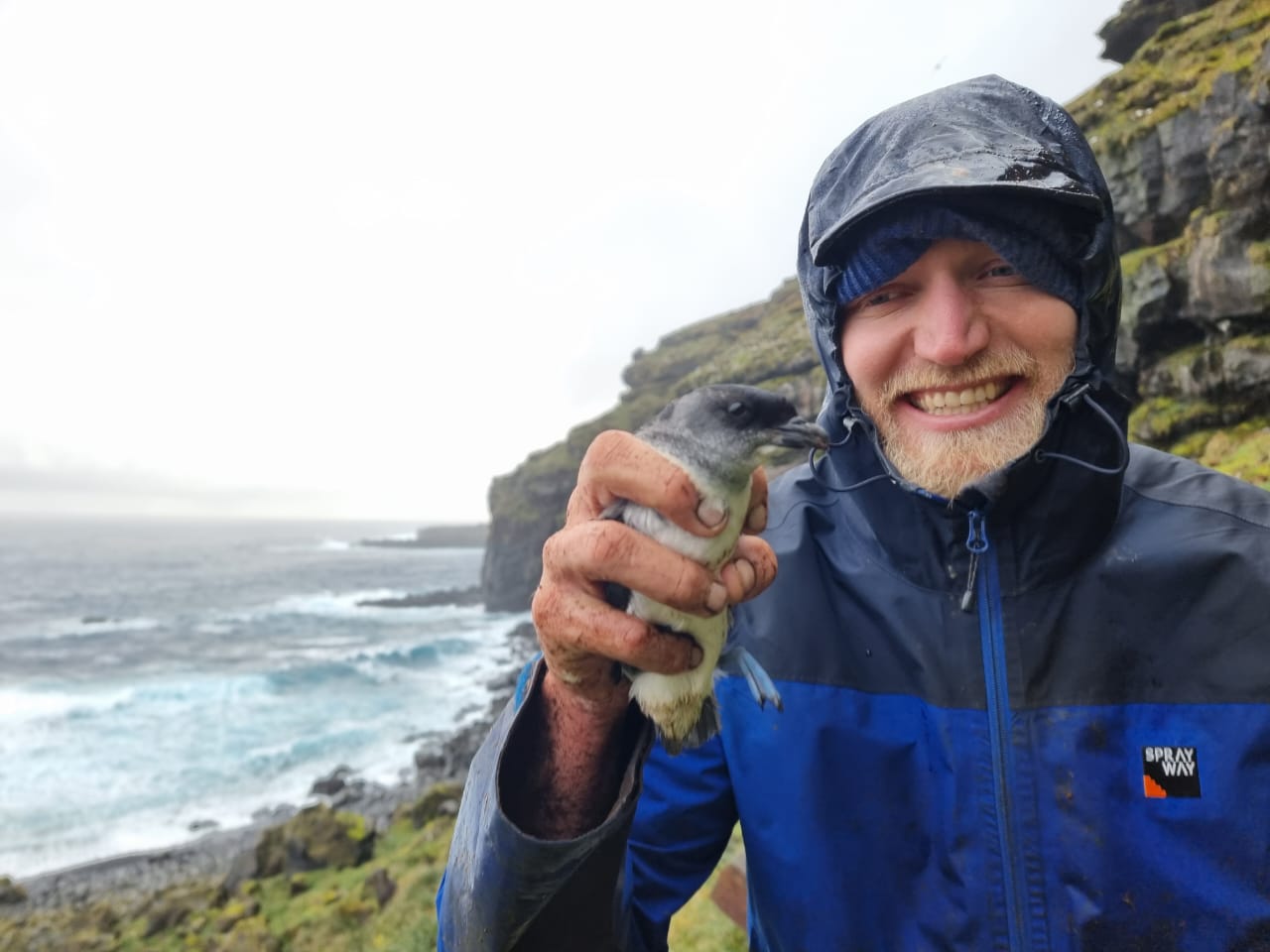 (left) Michelle Jones with Grey-headed Albatross and (right) Chris Jones with Common Diving Petrel
(left) Michelle Jones with Grey-headed Albatross and (right) Chris Jones with Common Diving Petrel
Principal Investigators
Take-Over Research team
Overwintering team 2023/24:
- Michelle Risi Jones (NMU/SAPRI)
- Christopher Jones (NMU)
- Text: Dr Maelle Connan
- Images : Chris and Michelle Jones

by Ria Olivier | Apr 3, 2024 | Announcement, Research, SANAP
The SANAP research projects approved for the cycle 2024-2026 are represented under the following Marine and Antarctic Strategy themes.
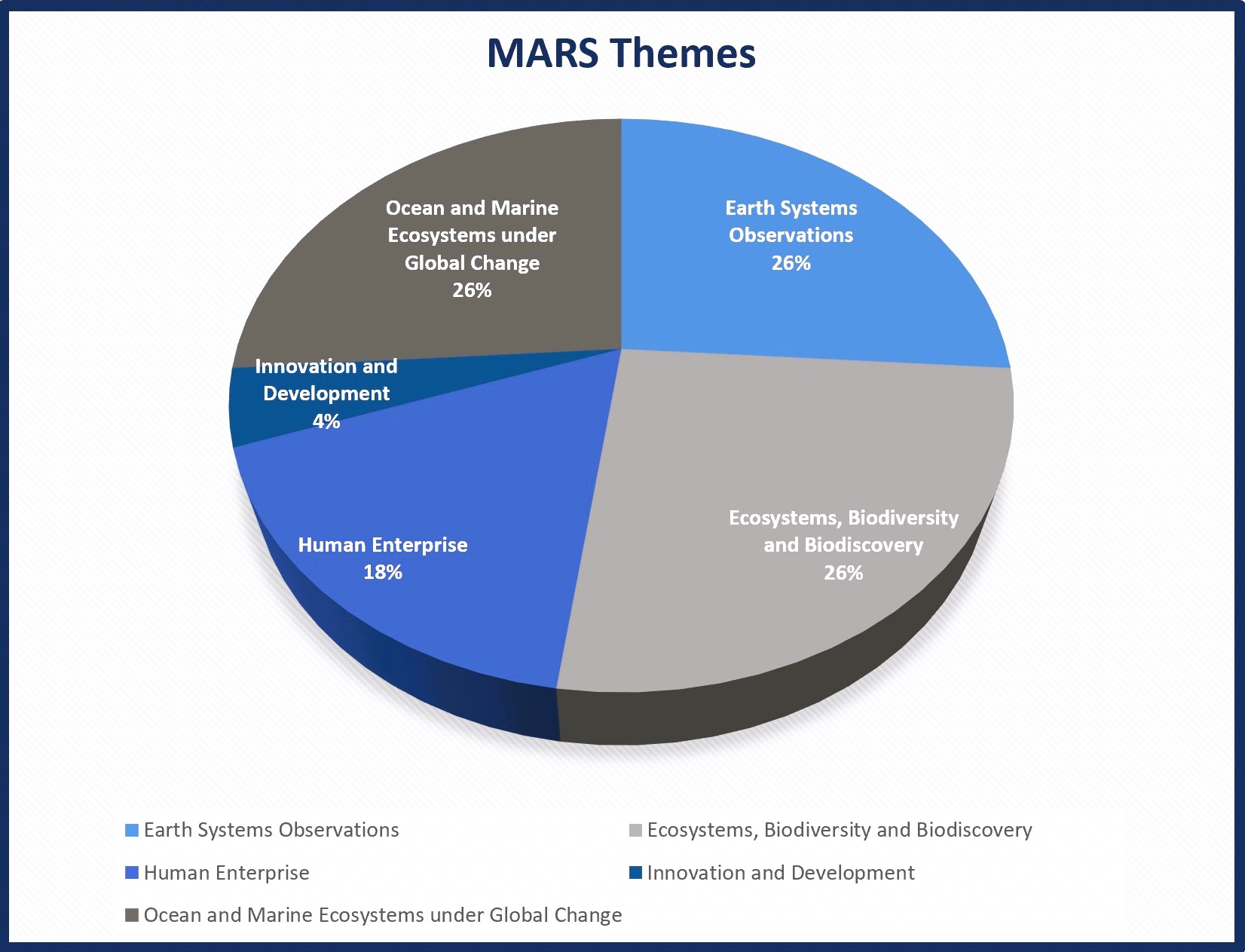
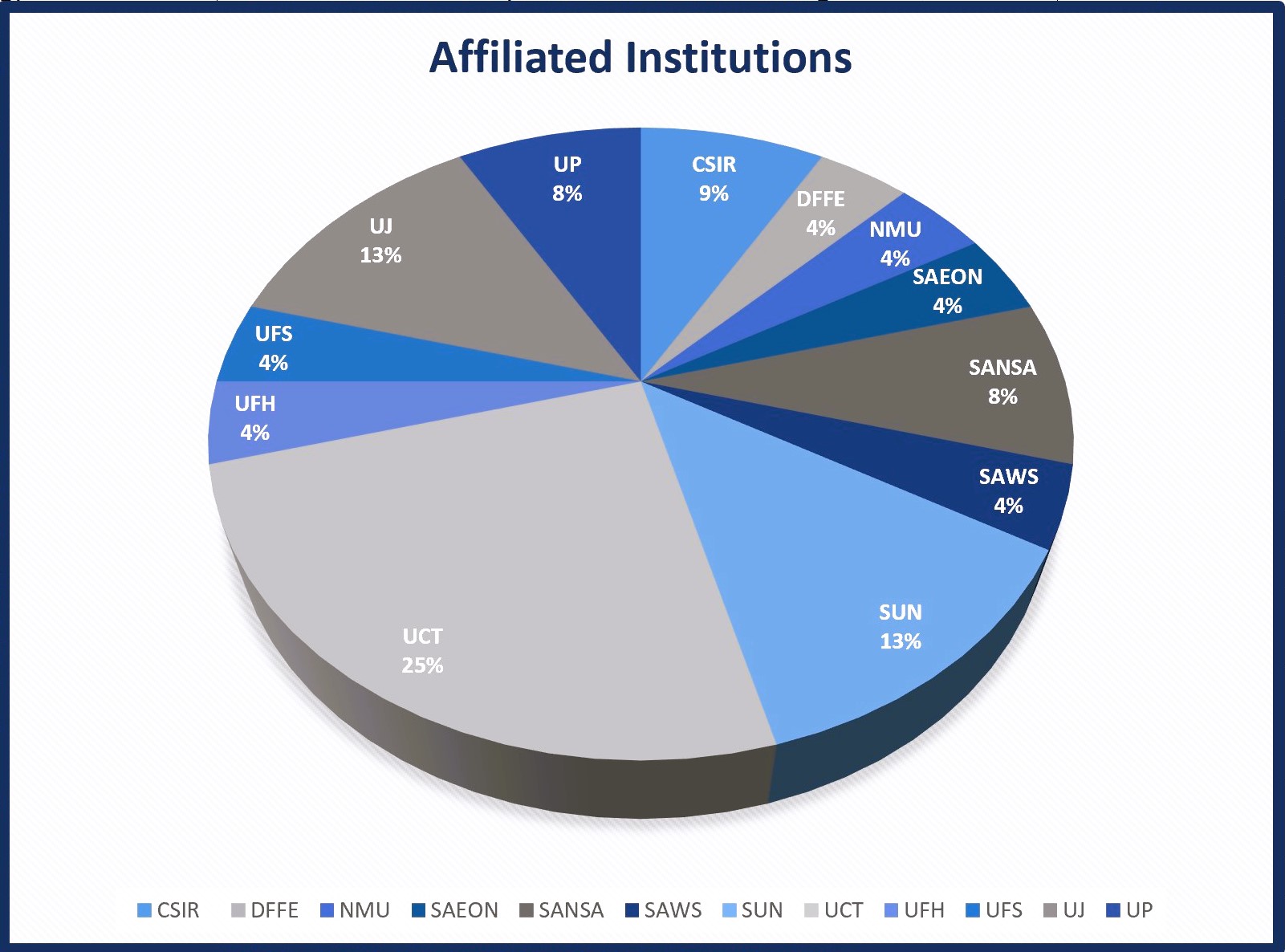
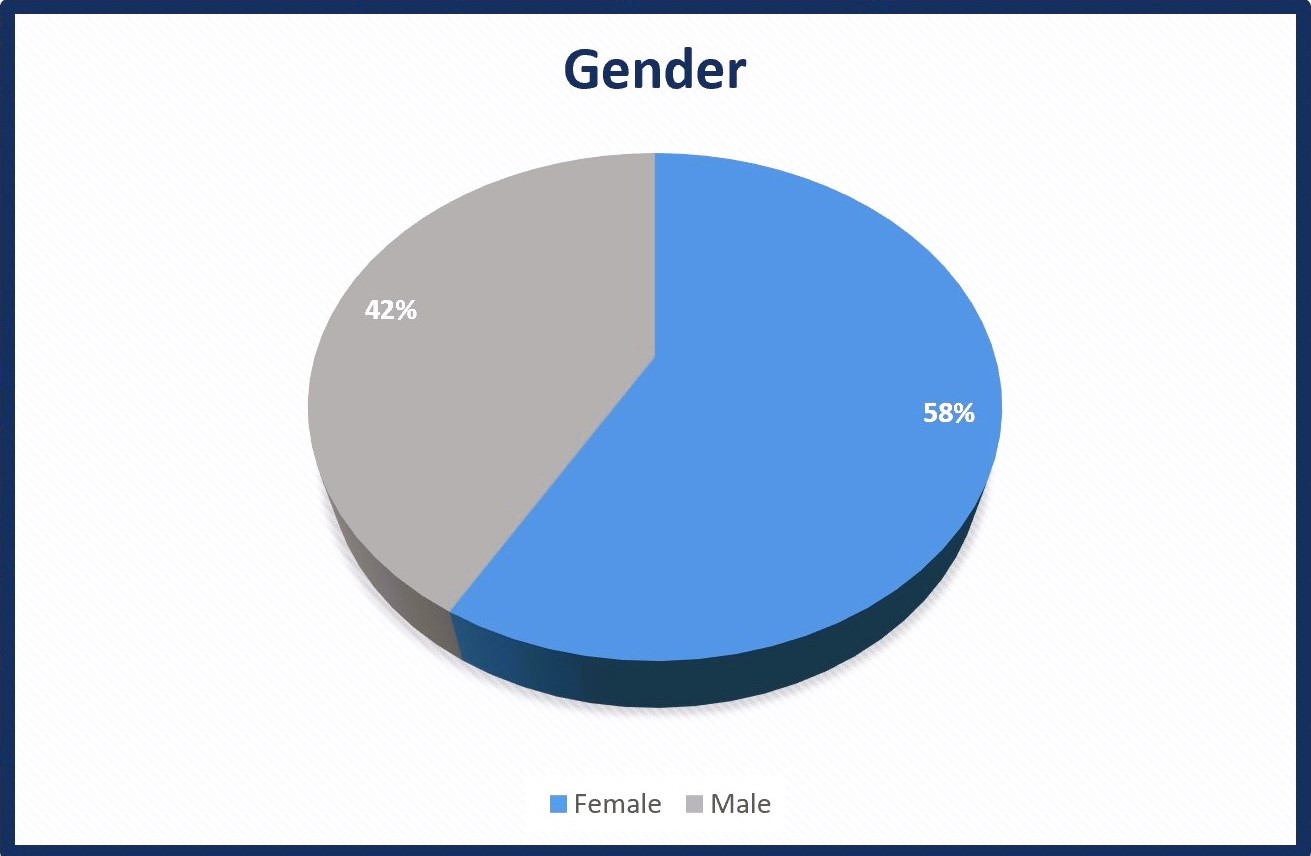
OCEAN and Marine Ecosystems under Global Change
- Antarctic MIZ Observations: Interdisciplinary approaches to resolve seasonal sea-ice variability. (UCT)
- Decoding the mercury cycle in the Southern Ocean: in situ observations and advanced modeling. (SAWS)
- ECOSOPHY – Emergent constraints on Southern Ocean phytoplankton physiology. (CSIR)
- Growth dynamics of sea ice and how they affect the sea ice mechanics. (UCT)
- Micronutrient and pollutant trace elements at the air-sea interface of the Southern Ocean. (SUN)
- Southern Ocean Carbon-Heat Nexus: mixed-layer processes & feedbacks for improved climate projections. (CSIR)
- The biological carbon pump in a changing Southern Ocean. (UCT)
Earth Systems Observations
- Crustal evolution of Dronning Maud Land (UJ)
- Landscape and Climate Interactions in the sub-Antarctic. (UFH)
- Polar Space Weather Studies (SANSA)
- Provenance and paleomagnetics of the rocks of the Grunehogna Craton in Western Dronning Maud Land. (UJ)
- SANAE HF radar. (SANSA)
- Structural Glaciological Analysis of North-Western Antarctic Ice Shelf – SANAS (UCT)
Ecosystems, Biodiversity and Biodiscovery
- Ecogenomics (UJ)
- Interactive effects of multiple stressors and environmental change on seabird breeding performance. (DFFE)
- Marion Island mouSe Ecology – MISE (UP)
- Marion Island Top Predator Long-Term Observations. (SAEON)
- On-island impacts of climate change on the Southern Ocean’s iconic seabirds. (UCT)
Innovation and development
- SA Agulhas II – Flagship for Vessel (4.0) – Part II (SUN)
Human Enterprise
- Antarctic Legacy of South Africa. (SUN)
- SEAmester – South Africa’s Floating University. ( UCT)
- South African Antarctic Artists and Writers Programme – AWP Pilot. (UP)
- The Marion Island Hut Book Project. (UFS)
For details and links see SANAP website.

by Ria Olivier | Mar 20, 2024 | Research, SA Agulhas II, SANAP, SEAmester
 Training Tomorrow’s Oceanographers
Training Tomorrow’s Oceanographers
SEAmester’s success is evident in the academic achievements of its participants. A total of 254 students from over 26 institutes and universities have participated in the program, gaining comprehensive knowledge in oceanography, marine biology, atmospheric forecasting and navigation. The curriculum, developed in collaboration with leading marine scientists and lecturers across South Africa, ensures a balance between theoretical concepts and practical training of skills. SEAmester participants have contributed to several news publications, presenting their findings at national and international (SANAP 2023, IUGG 2023, @SEAnetwork 2022, VC award Ocean Womxn) conferences and workshops.
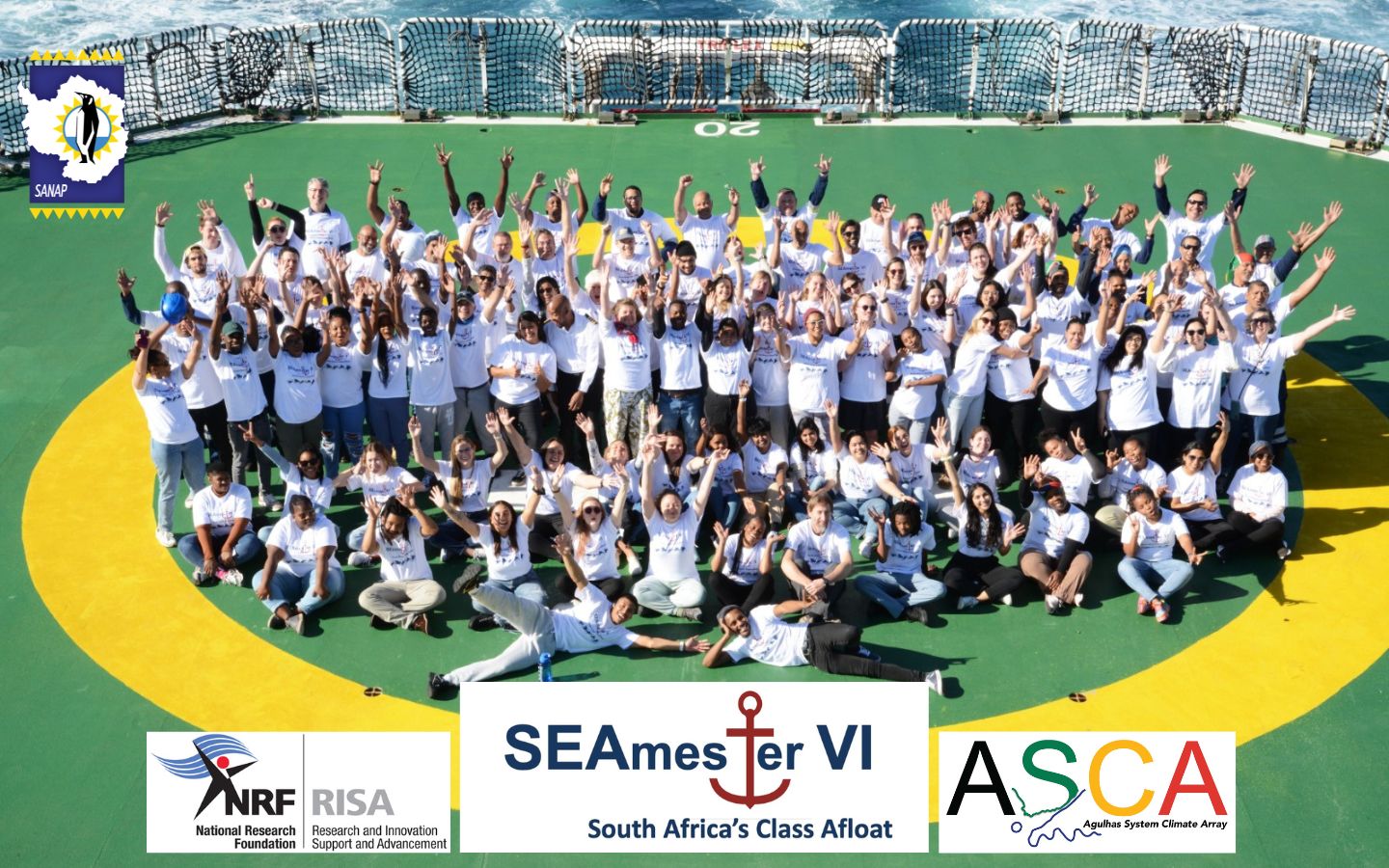 The program’s emphasis on research skills and scientific inquiry has empowered students to continue to make meaningful contributions to the field of marine science. Graduates of SEAmester have gone on to pursue advanced degrees and have secured positions in reputable research institutions, environmental organizations, and marine industries. The alumni network continues to grow, fostering collaboration and knowledge exchange between the cohort of SEAmester students. SEAmester’s success is further exemplified by the growing number of partnerships with academic institutions. Collaborative research projects, joint degree programs, and faculty exchanges have strengthened ties between SEAmester and leading universities in South Africa. International Collaborations: SEAmester is actively exploring partnerships with renowned international institutions to enhance the global reach of its educational offerings. Collaborative research projects and student exchanges will further enrich the program’s diversity and perspective. (Above SEAmester 2023)
The program’s emphasis on research skills and scientific inquiry has empowered students to continue to make meaningful contributions to the field of marine science. Graduates of SEAmester have gone on to pursue advanced degrees and have secured positions in reputable research institutions, environmental organizations, and marine industries. The alumni network continues to grow, fostering collaboration and knowledge exchange between the cohort of SEAmester students. SEAmester’s success is further exemplified by the growing number of partnerships with academic institutions. Collaborative research projects, joint degree programs, and faculty exchanges have strengthened ties between SEAmester and leading universities in South Africa. International Collaborations: SEAmester is actively exploring partnerships with renowned international institutions to enhance the global reach of its educational offerings. Collaborative research projects and student exchanges will further enrich the program’s diversity and perspective. (Above SEAmester 2023)
 As the field of ocean science evolves, SEAmester is committed to incorporating emerging disciplines such as marine robotics, climate science, and biotechnology into its curriculum. This ensures that students are well-prepared for the challenges and opportunities of the future direction and foci of marine sciences. Recognizing the importance of accessibility, SEAmester continues to develop and teach digital learning/mapping/visual platforms to complement its on-board training.
As the field of ocean science evolves, SEAmester is committed to incorporating emerging disciplines such as marine robotics, climate science, and biotechnology into its curriculum. This ensures that students are well-prepared for the challenges and opportunities of the future direction and foci of marine sciences. Recognizing the importance of accessibility, SEAmester continues to develop and teach digital learning/mapping/visual platforms to complement its on-board training.
“SEAmester gave me hope… hope that if you look, opportunities will unfold.” – Ntando.
Below examples of the many articles and presentations coming out of the programme…
A report which is a poll of all 6 SEAmester student cohorts on the importance of their SEAmester experience in shaping their studies, career trajectory etc. will be published soon.
IMAGES available on ALSA archive
Text by Isabelle Ansorge.
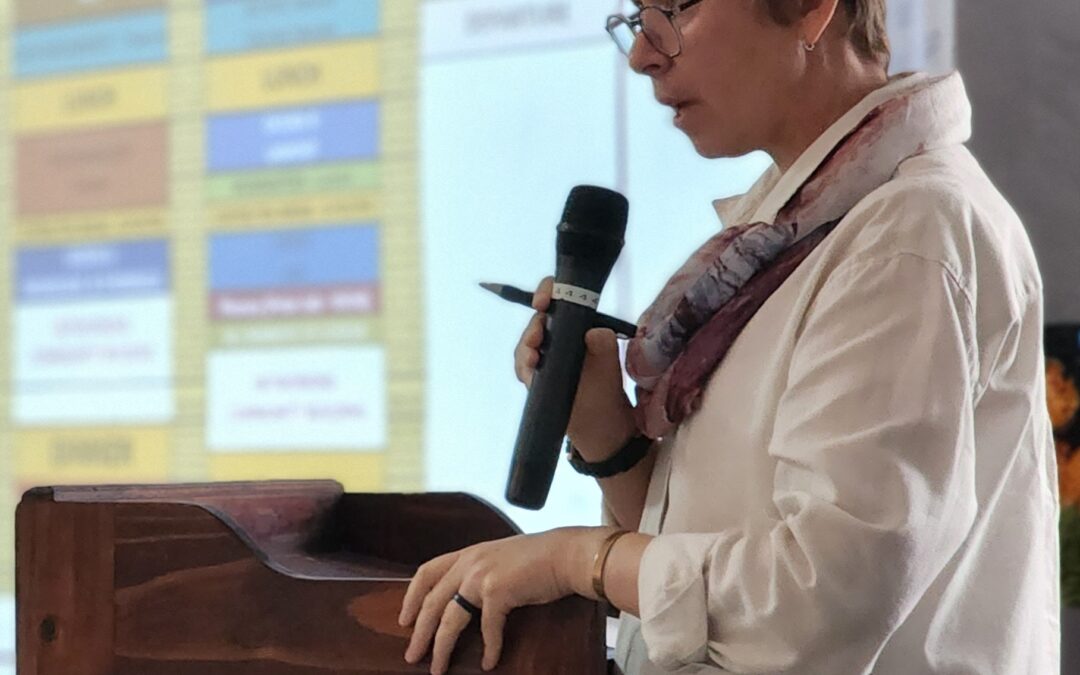
by Ria Olivier | Mar 8, 2024 | Research, SANAP, SANAP Student, Science
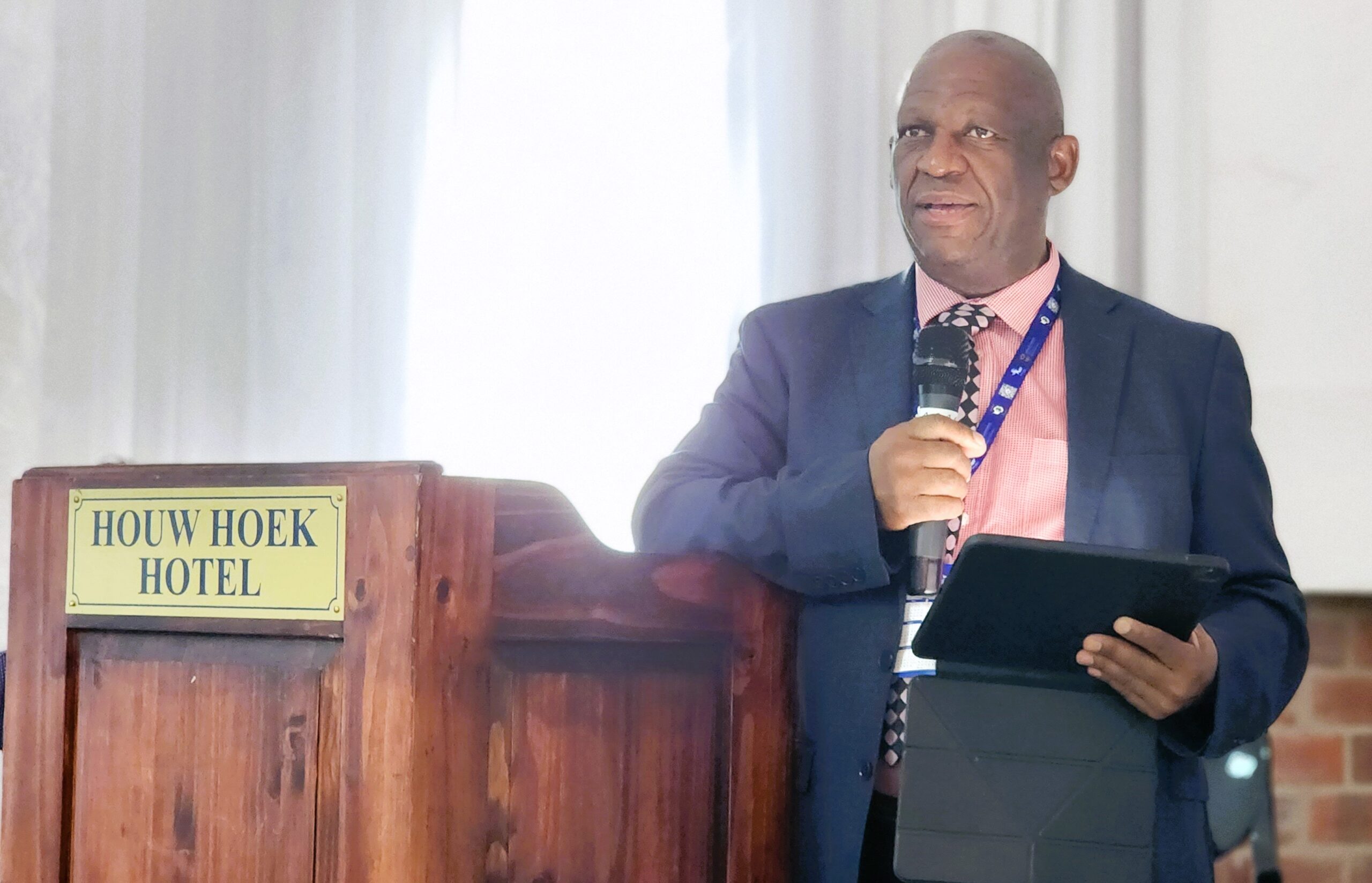 During the 6th SANAP symposium, time was allocated for the presentation of governance issues, and this was done on the first day during the opening ceremony. Dr Gilbert Siko , the Director of Marine & Polar Research at the Department of Science and Innovation gave the first presentation. His role within the Research Development and Support Programme it is to promote the development of research, the production of scientific knowledge, and human capital development in science areas in which South Africa enjoys a geographic advantage, that includes Antarctic and marine research. Dr Siko highlighted the strategic importance of the research conducted through the South African National Antarctic Programme.
During the 6th SANAP symposium, time was allocated for the presentation of governance issues, and this was done on the first day during the opening ceremony. Dr Gilbert Siko , the Director of Marine & Polar Research at the Department of Science and Innovation gave the first presentation. His role within the Research Development and Support Programme it is to promote the development of research, the production of scientific knowledge, and human capital development in science areas in which South Africa enjoys a geographic advantage, that includes Antarctic and marine research. Dr Siko highlighted the strategic importance of the research conducted through the South African National Antarctic Programme.
 Dr Siko was followed by Tracy Klarenbeek, Director of Knowledge Advancement and Support of the National Research Foundation (NRF). She highlighted that create innovative funding instruments such as SANAP serve to transform the scientific landscape and inspire a representative research community to aspire to global competitiveness. She shared the outcomes of the 2023 SANAP Call for Proposals for funding cycle 2024 – 2026 with the community. She also mentioned that mentorship initiatives for unsuccessful applicants would be implemented via SAPRI.(right)
Dr Siko was followed by Tracy Klarenbeek, Director of Knowledge Advancement and Support of the National Research Foundation (NRF). She highlighted that create innovative funding instruments such as SANAP serve to transform the scientific landscape and inspire a representative research community to aspire to global competitiveness. She shared the outcomes of the 2023 SANAP Call for Proposals for funding cycle 2024 – 2026 with the community. She also mentioned that mentorship initiatives for unsuccessful applicants would be implemented via SAPRI.(right)
Dr Siko was followed by Tracy Klarenbeek, Director of Knowledge Advancement and Support of the National Research Foundation (NRF). She highlighted that create innovative funding instruments such as SANAP serve to transform the scientific landscape and inspire a representative research community to aspire to global competitiveness. She shared the outcomes of the 2023 SANAP Call for Proposals for funding cycle 2024 – 2026 with the community. She also mentioned that mentorship initiatives for unsuccessful applicants would be implemented via SAPRI.
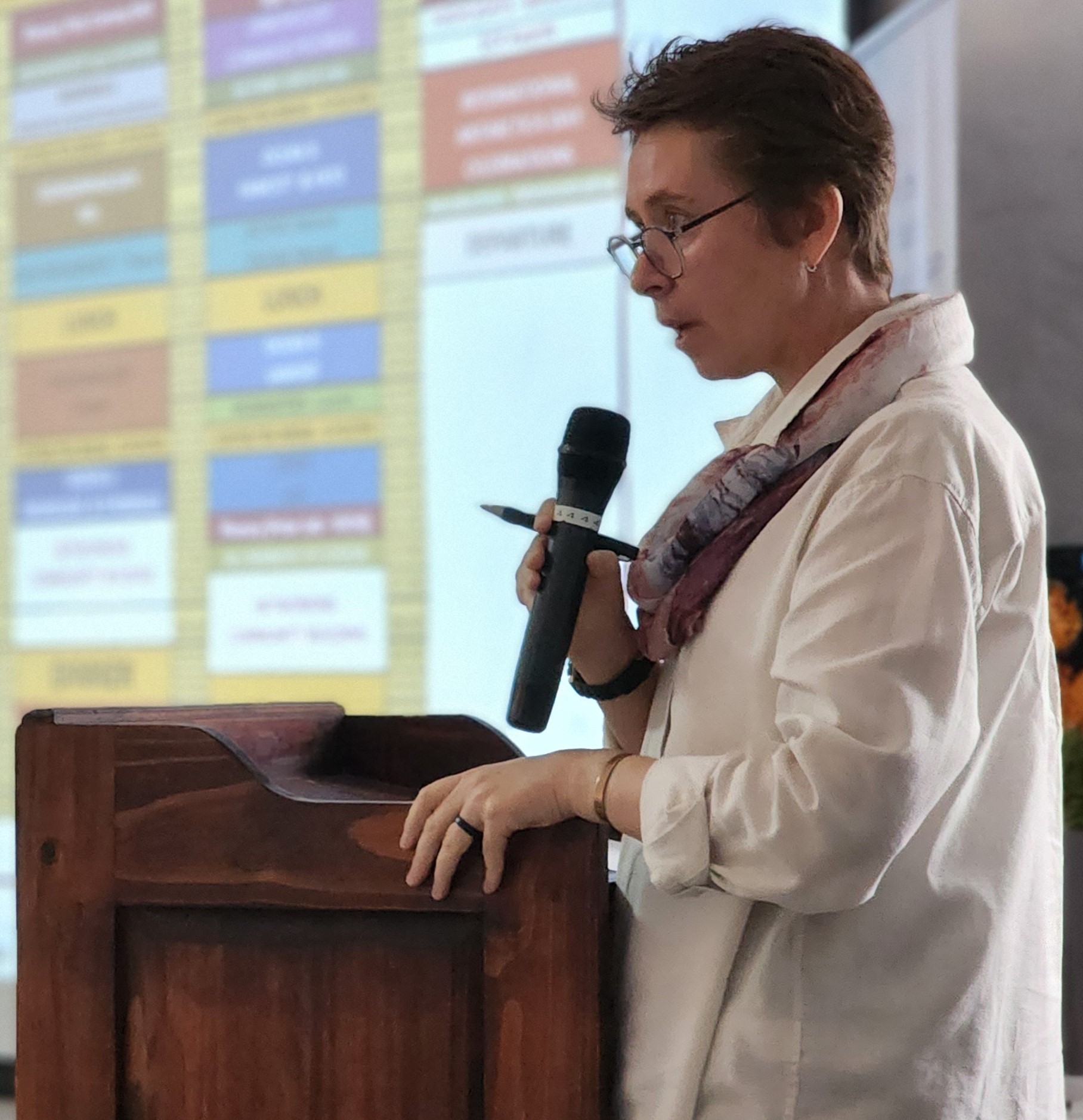
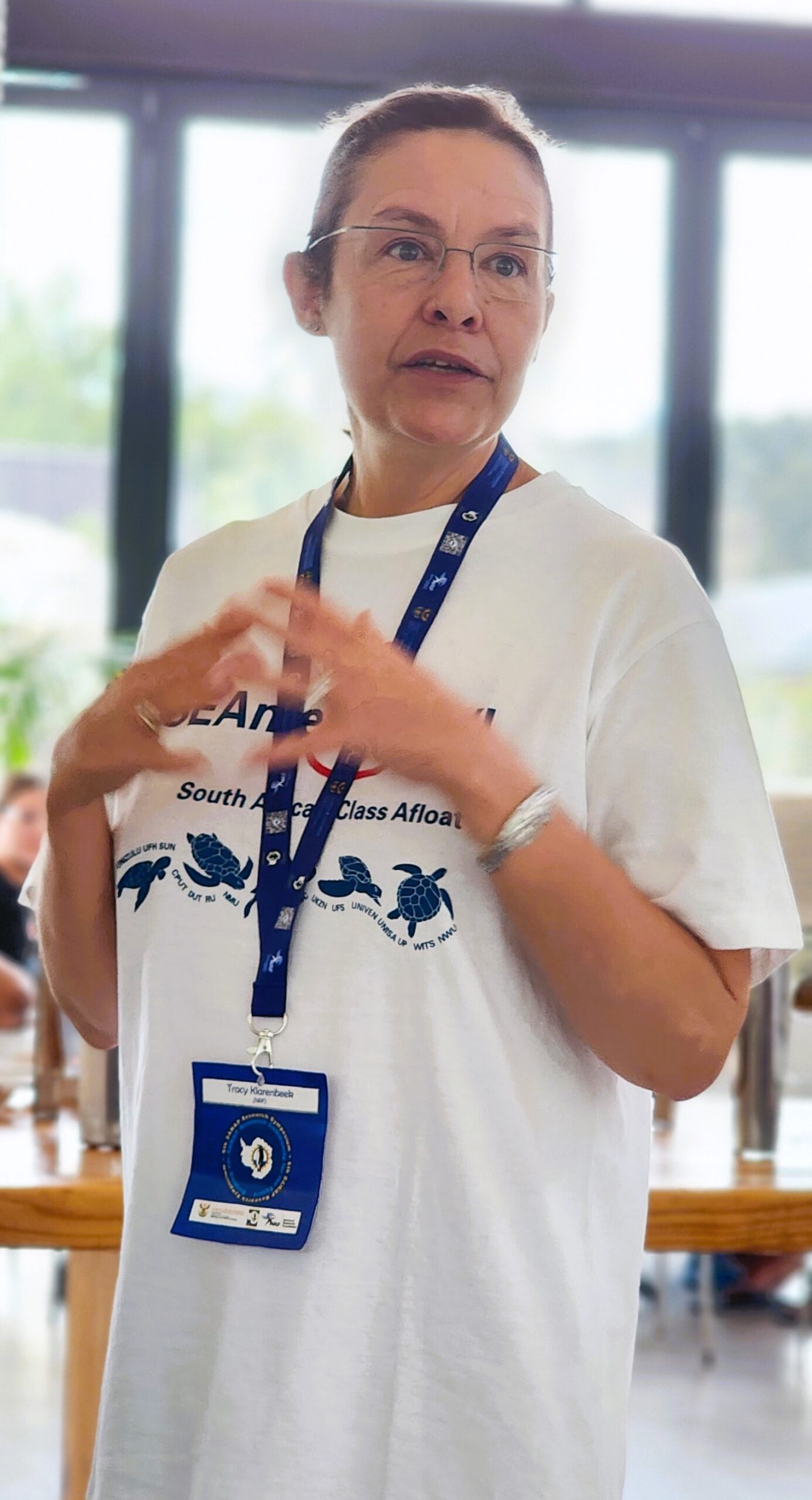 Prof Bettine van Vuuren (right), Chair of the South African National Committee for SCAR gave feedback on the committee meeting. She also highlighted the function and activities of SCAR and the importance to be informed of these activities, and to be aware of scholarship opportunities. She encouraged early career researchers to become involved in SCAR committees and action scholarships.
Prof Bettine van Vuuren (right), Chair of the South African National Committee for SCAR gave feedback on the committee meeting. She also highlighted the function and activities of SCAR and the importance to be informed of these activities, and to be aware of scholarship opportunities. She encouraged early career researchers to become involved in SCAR committees and action scholarships.
The highlight of the Symposium was the international Antarctic day celebrations where Tracy Klarenbeek (left)addressed all attendees during the closing ceremony with a heartfelt talk. All participants, old and new, were thanked for their participation in the Symposium and their dedication to the SANAP programme. Tracy Klarenbeek talk gave a personal perspective of administering the SANAP programme:
“by facilitating Antarctic and Southern Ocean research, and awarding student bursaries, it is evident that the work I do changes lives”.
The opportunity to access the Southern Ocean, Antarctica and the sub-Antarctic islands (Gough and the Prince Edward Islands) is limited to the lucky few, and the work of the National Research Foundation makes this a reality for researchers and students alike.
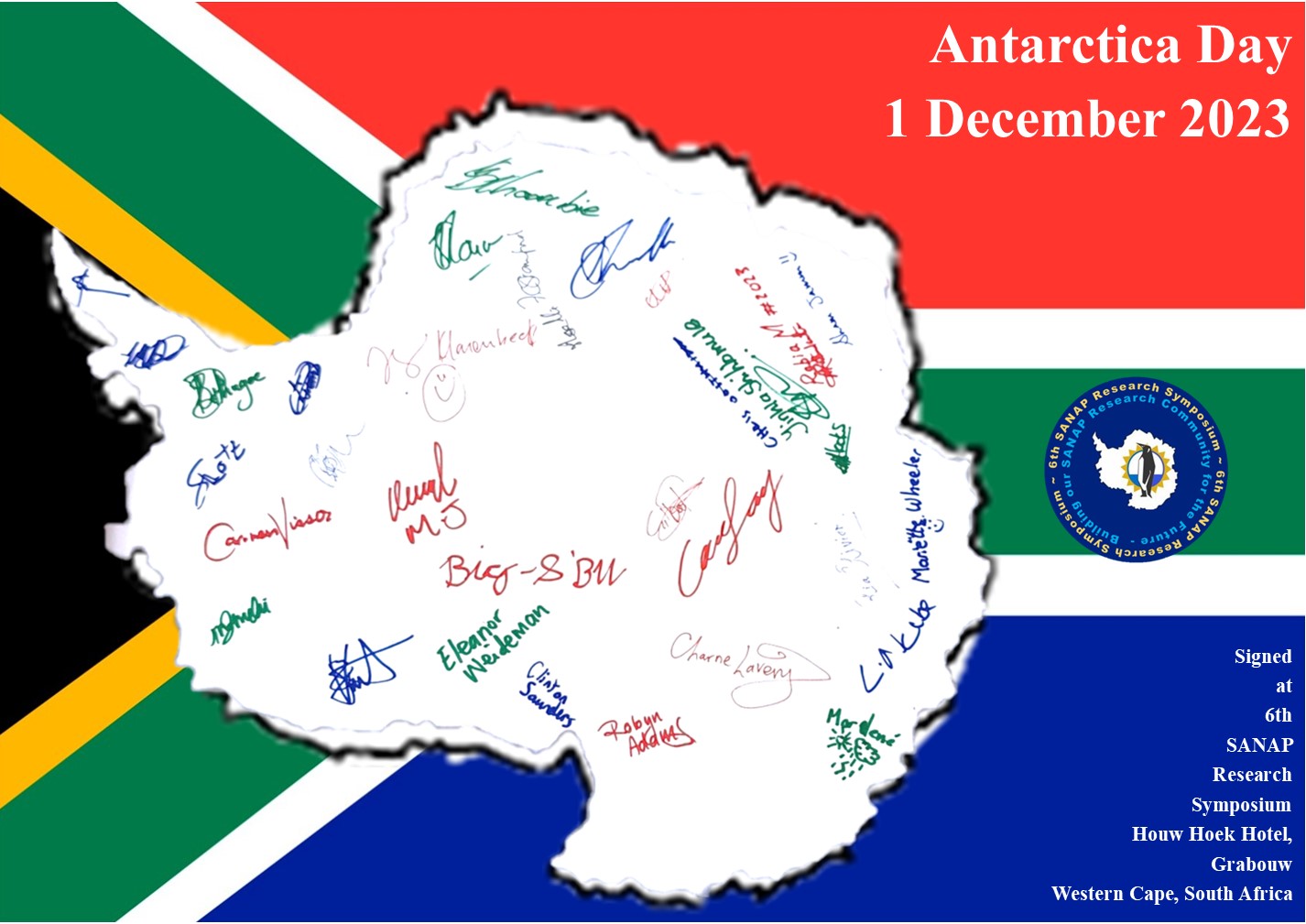 A printed Map of Antarctica was signed by everyone on International Antarctica Day 1st December 2023 at Houw Hoek Hotel!
A printed Map of Antarctica was signed by everyone on International Antarctica Day 1st December 2023 at Houw Hoek Hotel!
Speakers photos: credit Anche Louw – SA Polar Research Infrastructure/Antarctic Legacy of SA
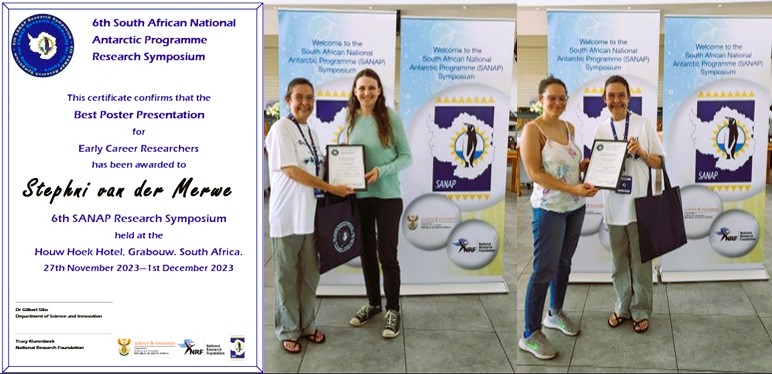
by Ria Olivier | Mar 6, 2024 | APECSSA, Research, SANAP, SANAP Student
 The Early Career Event at the SANAP symposium was a first for Early Career Researchers(ECR), but also for the first time during a SANAP symposium recognition was given for oral and poster presentations done by ECR’s. (above9l-r): Awardees – Joshua Tsamba, Saffiyah Moos, Ben Steyn, Stephni van der Merwe, Lillina Ruiters, Morgan Raath-Kruger)
The Early Career Event at the SANAP symposium was a first for Early Career Researchers(ECR), but also for the first time during a SANAP symposium recognition was given for oral and poster presentations done by ECR’s. (above9l-r): Awardees – Joshua Tsamba, Saffiyah Moos, Ben Steyn, Stephni van der Merwe, Lillina Ruiters, Morgan Raath-Kruger)
 (l-r): Joshua Tsamba, Saffiyah Moos, Ben Steyn receiving their certificates
(l-r): Joshua Tsamba, Saffiyah Moos, Ben Steyn receiving their certificates
Oral Presentations:
- 1st Joshua Tsamba: The first record of fungal endophytes associated with the sub-Antarctic cushion plant, Azorella selago (Apiaceae) on Marion Island. PI – Dr Michele Greve (Abstract)
- 2nd Safiyyah Moos: Investigating the dynamics and exchanges across the ice-ocean interface in artificial sea ice. PI – Dr Tokoloho Rampai (Abstract)
- 3rd Ben Steyn: A Longitudinal Study of the Open-Water Performance of an Ice-Class Vessel. PI- Prof Annie Bekker (Abstract)
 (l-r) Certificates handed to Stephni van der Merwe, Lillina Ruiters, Morgan Raath Kruger( had to leave before ceremony)
(l-r) Certificates handed to Stephni van der Merwe, Lillina Ruiters, Morgan Raath Kruger( had to leave before ceremony)
Poster Presentations:
- 1st Stephni van der Merwe: Long-term vegetation change (1965-2020) in response to rapid warming and drying in a sub-Antarctic tundra: evidence from repeat photography. PI – Dr Michelle Greve (Abstract)
- 2nd Lillina Ruiters: Variability of phytoplankton photo physiology in the Southern Ocean: an analysis of assumptions and uncertainties . PI- Dr Sandy Thomalla (Abstract)
- 3rd Morgan Raath- Kruger: Do anisotropic processes influence fine-scale spatial genetic structure of a keystone sub-Antarctic plant species? PI – Prof Peter Le Roux (Abstract)
The symposium was an opportunity for human capital development. It is supported by the government and a peer-reviewed research programme that will provide future opportunities for all young, early career and established researchers working in the Southern Ocean, Antarctica and Islands. The students had the opportunity to present their work to a wider audience either in an oral or poster presentation. The SANAP symposium gave the students planning to present on international a ‘practice run’ with feedback.
 Awards for oral and poster presentations were given to early-career scientists. These awards were to give recognition to Early career researchers and the effort they did in preparing and presenting their research. Principal Investigators made themselves available to mark presentations of ECR’s via a marksheet and we appreciate their time and comments. We congratulate the awardees and their Principal investigators and hope this recognition will motivate them in their career development. (above: Michelle Greve, Sandy Thomalla, Annie Bekker, Tokoloho Rampai, Peter le Roux)
Awards for oral and poster presentations were given to early-career scientists. These awards were to give recognition to Early career researchers and the effort they did in preparing and presenting their research. Principal Investigators made themselves available to mark presentations of ECR’s via a marksheet and we appreciate their time and comments. We congratulate the awardees and their Principal investigators and hope this recognition will motivate them in their career development. (above: Michelle Greve, Sandy Thomalla, Annie Bekker, Tokoloho Rampai, Peter le Roux)
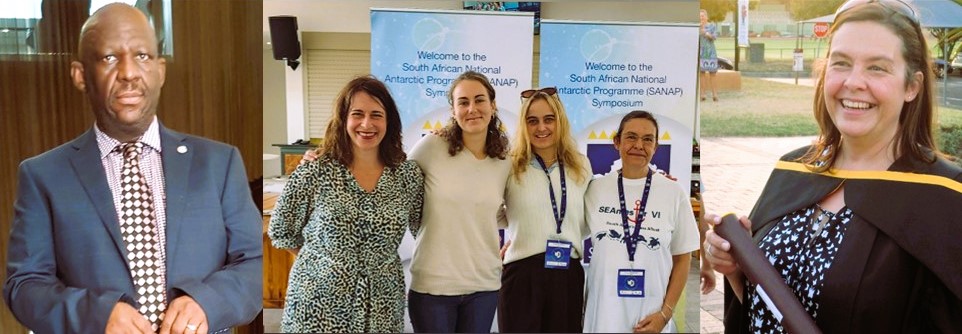 Certificates signed by Dr Gilbert Siko of the Department of Science and innovation and Ms Tracy Klarenbeek form the National Research Foundation were handed to the recipients. There were a few Honours students that participate in the symposium and there presentations were of high standard and although they do not qualify for the ECR awards we would like to mention Sarah du Preez and Amber Sneddon for their Presentations. (above (l-R): Dr Gilbert Siko, Honour students with Annie Bekker and Tracy Klarenbeek, Tracy Klarenbeek)
Certificates signed by Dr Gilbert Siko of the Department of Science and innovation and Ms Tracy Klarenbeek form the National Research Foundation were handed to the recipients. There were a few Honours students that participate in the symposium and there presentations were of high standard and although they do not qualify for the ECR awards we would like to mention Sarah du Preez and Amber Sneddon for their Presentations. (above (l-R): Dr Gilbert Siko, Honour students with Annie Bekker and Tracy Klarenbeek, Tracy Klarenbeek)
Images of ceremony credit: Anche Louw (SA Polar Research Infrastructure and Antarctic Legacy of SA)

 Announcing a 2nd Edition of the Special Issue focused on “Antarctic Remote Sensing Applications” that will be published in the journal Remote Sensing (IF: 5.000).
Announcing a 2nd Edition of the Special Issue focused on “Antarctic Remote Sensing Applications” that will be published in the journal Remote Sensing (IF: 5.000). The focus of this Special Issue will be on changes that have been and are undergoing in Antarctica mostly driven by climate change but as well by tectonics, volcanism, and erosion, that causes adaptation of Antarctic biota’s occupation and mobility, and of Human presence. Research papers focused on Antarctica that analyze data acquired by remotely operated sensors within the Remote Sensing scope are welcome to this special issue, in particular:
The focus of this Special Issue will be on changes that have been and are undergoing in Antarctica mostly driven by climate change but as well by tectonics, volcanism, and erosion, that causes adaptation of Antarctic biota’s occupation and mobility, and of Human presence. Research papers focused on Antarctica that analyze data acquired by remotely operated sensors within the Remote Sensing scope are welcome to this special issue, in particular: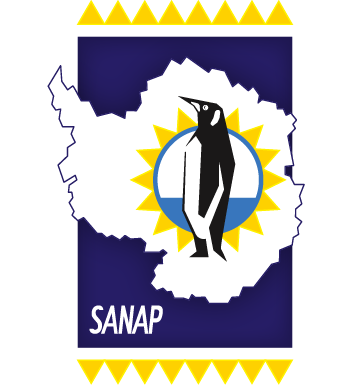

 ABOVE: Michelle Jones (M80), Vanessa Steven (M81), Prof Susie Cunningham (UCT FitzPatrick PI), Rhiannon Gill (M81), Prof Peter Ryan (UCT FitzPatrick), Chris Jones (M80)
ABOVE: Michelle Jones (M80), Vanessa Steven (M81), Prof Susie Cunningham (UCT FitzPatrick PI), Rhiannon Gill (M81), Prof Peter Ryan (UCT FitzPatrick), Chris Jones (M80)
 Above: Chris and Michelle Jones working with the Wandering Albatross during overwinter period
Above: Chris and Michelle Jones working with the Wandering Albatross during overwinter period
 (left) Michelle Jones with Grey-headed Albatross and (right) Chris Jones with Common Diving Petrel
(left) Michelle Jones with Grey-headed Albatross and (right) Chris Jones with Common Diving Petrel




 Training Tomorrow’s Oceanographers
Training Tomorrow’s Oceanographers The program’s emphasis on research skills and scientific inquiry has empowered students to continue to make meaningful contributions to the field of marine science. Graduates of SEAmester have gone on to pursue advanced degrees and have secured positions in reputable research institutions, environmental organizations, and marine industries. The alumni network continues to grow, fostering collaboration and knowledge exchange between the cohort of SEAmester students. SEAmester’s success is further exemplified by the growing number of partnerships with academic institutions. Collaborative research projects, joint degree programs, and faculty exchanges have strengthened ties between SEAmester and leading universities in South Africa. International Collaborations: SEAmester is actively exploring partnerships with renowned international institutions to enhance the global reach of its educational offerings. Collaborative research projects and student exchanges will further enrich the program’s diversity and perspective. (Above SEAmester 2023)
The program’s emphasis on research skills and scientific inquiry has empowered students to continue to make meaningful contributions to the field of marine science. Graduates of SEAmester have gone on to pursue advanced degrees and have secured positions in reputable research institutions, environmental organizations, and marine industries. The alumni network continues to grow, fostering collaboration and knowledge exchange between the cohort of SEAmester students. SEAmester’s success is further exemplified by the growing number of partnerships with academic institutions. Collaborative research projects, joint degree programs, and faculty exchanges have strengthened ties between SEAmester and leading universities in South Africa. International Collaborations: SEAmester is actively exploring partnerships with renowned international institutions to enhance the global reach of its educational offerings. Collaborative research projects and student exchanges will further enrich the program’s diversity and perspective. (Above SEAmester 2023) As the field of ocean science evolves, SEAmester is committed to incorporating emerging disciplines such as marine robotics, climate science, and biotechnology into its curriculum. This ensures that students are well-prepared for the challenges and opportunities of the future direction and foci of marine sciences. Recognizing the importance of accessibility, SEAmester continues to develop and teach digital learning/mapping/visual platforms to complement its on-board training.
As the field of ocean science evolves, SEAmester is committed to incorporating emerging disciplines such as marine robotics, climate science, and biotechnology into its curriculum. This ensures that students are well-prepared for the challenges and opportunities of the future direction and foci of marine sciences. Recognizing the importance of accessibility, SEAmester continues to develop and teach digital learning/mapping/visual platforms to complement its on-board training.
 During the 6th SANAP symposium, time was allocated for the presentation of governance issues, and this was done on the first day during the opening ceremony. Dr Gilbert Siko , the Director of Marine & Polar Research at the Department of Science and Innovation gave the first presentation. His role within the Research Development and Support Programme it is to promote the development of research, the production of scientific knowledge, and human capital development in science areas in which South Africa enjoys a geographic advantage, that includes Antarctic and marine research. Dr Siko highlighted the strategic importance of the research conducted through the South African National Antarctic Programme.
During the 6th SANAP symposium, time was allocated for the presentation of governance issues, and this was done on the first day during the opening ceremony. Dr Gilbert Siko , the Director of Marine & Polar Research at the Department of Science and Innovation gave the first presentation. His role within the Research Development and Support Programme it is to promote the development of research, the production of scientific knowledge, and human capital development in science areas in which South Africa enjoys a geographic advantage, that includes Antarctic and marine research. Dr Siko highlighted the strategic importance of the research conducted through the South African National Antarctic Programme. Dr Siko was followed by Tracy Klarenbeek, Director of Knowledge Advancement and Support of the National Research Foundation (NRF). She highlighted that create innovative funding instruments such as SANAP serve to transform the scientific landscape and inspire a representative research community to aspire to global competitiveness. She shared the outcomes of the 2023 SANAP Call for Proposals for funding cycle 2024 – 2026 with the community. She also mentioned that mentorship initiatives for unsuccessful applicants would be implemented via SAPRI.(right)
Dr Siko was followed by Tracy Klarenbeek, Director of Knowledge Advancement and Support of the National Research Foundation (NRF). She highlighted that create innovative funding instruments such as SANAP serve to transform the scientific landscape and inspire a representative research community to aspire to global competitiveness. She shared the outcomes of the 2023 SANAP Call for Proposals for funding cycle 2024 – 2026 with the community. She also mentioned that mentorship initiatives for unsuccessful applicants would be implemented via SAPRI.(right)
 Prof Bettine van Vuuren (right), Chair of the
Prof Bettine van Vuuren (right), Chair of the  A printed Map of Antarctica was signed by everyone on International Antarctica Day 1st December 2023 at Houw Hoek Hotel!
A printed Map of Antarctica was signed by everyone on International Antarctica Day 1st December 2023 at Houw Hoek Hotel!
 The Early Career Event at the SANAP symposium was a first for Early Career Researchers(ECR), but also for the first time during a SANAP symposium recognition was given for oral and poster presentations done by ECR’s. (above9l-r): Awardees – Joshua Tsamba, Saffiyah Moos, Ben Steyn, Stephni van der Merwe, Lillina Ruiters, Morgan Raath-Kruger)
The Early Career Event at the SANAP symposium was a first for Early Career Researchers(ECR), but also for the first time during a SANAP symposium recognition was given for oral and poster presentations done by ECR’s. (above9l-r): Awardees – Joshua Tsamba, Saffiyah Moos, Ben Steyn, Stephni van der Merwe, Lillina Ruiters, Morgan Raath-Kruger) (l-r): Joshua Tsamba, Saffiyah Moos, Ben Steyn receiving their certificates
(l-r): Joshua Tsamba, Saffiyah Moos, Ben Steyn receiving their certificates Awards for oral and poster presentations were given to early-career scientists. These awards were to give recognition to Early career researchers and the effort they did in preparing and presenting their research. Principal Investigators made themselves available to mark presentations of ECR’s via a marksheet and we appreciate their time and comments. We congratulate the awardees and their Principal investigators and hope this recognition will motivate them in their career development. (above: Michelle Greve, Sandy Thomalla, Annie Bekker, Tokoloho Rampai, Peter le Roux)
Awards for oral and poster presentations were given to early-career scientists. These awards were to give recognition to Early career researchers and the effort they did in preparing and presenting their research. Principal Investigators made themselves available to mark presentations of ECR’s via a marksheet and we appreciate their time and comments. We congratulate the awardees and their Principal investigators and hope this recognition will motivate them in their career development. (above: Michelle Greve, Sandy Thomalla, Annie Bekker, Tokoloho Rampai, Peter le Roux) Certificates signed by Dr Gilbert Siko of the Department of Science and innovation and Ms Tracy Klarenbeek form the National Research Foundation were handed to the recipients. There were a few Honours students that participate in the symposium and there presentations were of high standard and although they do not qualify for the ECR awards we would like to mention Sarah du Preez and Amber Sneddon for their Presentations. (above (l-R): Dr Gilbert Siko, Honour students with Annie Bekker and Tracy Klarenbeek, Tracy Klarenbeek)
Certificates signed by Dr Gilbert Siko of the Department of Science and innovation and Ms Tracy Klarenbeek form the National Research Foundation were handed to the recipients. There were a few Honours students that participate in the symposium and there presentations were of high standard and although they do not qualify for the ECR awards we would like to mention Sarah du Preez and Amber Sneddon for their Presentations. (above (l-R): Dr Gilbert Siko, Honour students with Annie Bekker and Tracy Klarenbeek, Tracy Klarenbeek)
